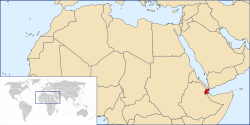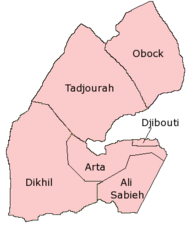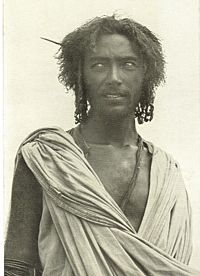Djibouti
| Republic of Djibouti
جمهورية جيبوتي
Jumhūriyyat Jībūtī Jamhuuriyadda Jabuuti République de Djibouti |
||||||
|---|---|---|---|---|---|---|
|
||||||
| Motto: "Unité, Égalité, Paix" (transliteration) "Unity, Equality, Peace" |
||||||
| Anthem: Djibouti |
||||||
 |
||||||
| Capital (and largest city) |
Djibouti |
|||||
| Official languages | Arabic and French[1] | |||||
| Recognised regional languages | Afar, Somali | |||||
| Demonym | Djiboutian | |||||
| Government | Semi-presidential republic | |||||
| - | President | Ismail Omar Guelleh | ||||
| - | Prime Minister | Dileita Mohamed Dileita | ||||
| Independence | from France | |||||
| - | Date | June 27 1977 | ||||
| Area | ||||||
| - | Total | 23,200 km2 (149th) 8,958 sq mi |
||||
| - | Water (%) | 0.09 (20 km² / 7.7 sq mi) | ||||
| Population | ||||||
| - | July 2007 estimate | 496,374[1] (160th) | ||||
| - | 2000 census | 460,700 | ||||
| - | Density | 22/km2 (168th) 55/sq mi |
||||
| GDP (PPP) | 2007 estimate | |||||
| - | Total | $1.740 billion[2] | ||||
| - | Per capita | $2,273[2] | ||||
| GDP (nominal) | 2007 estimate | |||||
| - | Total | $850 million[2] | ||||
| - | Per capita | $1,110[2] | ||||
| HDI (2007) | 0.516 (medium) (149th) | |||||
| Currency | Franc (DJF) |
|||||
| Time zone | EAT (UTC+3) | |||||
| - | Summer (DST) | not observed (UTC+3) | ||||
| Drives on the | right | |||||
| Internet TLD | .dj | |||||
| Calling code | 253 | |||||
Djibouti (Arabic: جيبوتي Jībūtī, Somali: Jabuuti), officially the Republic of Djibouti, is a country in the Horn of Africa. It is bordered by Eritrea in the north, Ethiopia in the west and south, and Somalia in the southeast. The remainder of the border is formed by the Red Sea and the Gulf of Aden. On the other side of the Red Sea, on the Arabian Peninsula, 20 kilometres (12 mi) from the coast of Djibouti, is Yemen. The capital of Djibouti is the city of Djibouti.
Contents |
History
The history of Djibouti is recorded in poetry and in songs of its nomadic people and goes back thousands of years to a time when Djiboutians traded hides and skins for the perfumes and spices of ancient Egypt, India, and China. Through close contacts with the Arabian peninsula for more than 1,000 years, the Somali and Afar tribes in this region became among the first on the African continent to accept Islam.
French interest developed in the nineteenth century when the area was ruled by the sultan of Raheita, Tadjoura and Gobaad. The French bought the anchorage of Obock in 1862 and expanded it eventually to a colony called French Somaliland with essentially the current boundaries. In 1967 the area became the French Territory of the Afars and the Issas.
The Republic of Djibouti gained its independence from France on June 27,1977. Djibouti is a Somali, Afar and Islamic country which regularly takes part in Islamic affairs as well as Arab meetings.
Politics
Djibouti is a semi-presidential republic, with executive power in the central government, and legislative power in both the government and parliament. The parliamentary party system is dominated by the People's Rally for Progress and the President who currently is Ismail Omar Guelleh. The country's current constitution was approved in September 1992. Djibouti is a one party dominant state with the People's Rally for Progress in power. Opposition parties are allowed, but have no real chance of gaining power (see Elections in Djibouti).
The government is seen as being controlled by the Somali Issa clan. The country has recently come out of a decade long civil war, with the government and the Front for the Restoration of Unity and Democracy (FRUD) signing a peace treaty in 2000. Two FRUD members are part of the current cabinet.
Djibouti's second president, Guelleh was first elected to office in 1999, taking over from Hassan Gouled Aptidon, who had ruled the country since its independence from France in 1977.[3] Despite elections of the 1990s being described as "generally fair", Guelleh was sworn in for his second and final six year term as president in a one-man race on 8 April 2005. He took 100% of the votes in a 78.9% turnout.
The prime minister, who follows the council of ministers ('cabinet'), is appointed by the President. The parliament - the Chambre des Députés - consists of 52 members who are selected every five to nine years.
In 2001, the Djiboutian government leased the former French Foreign Legion base Camp Lemonier to the United States. Camp Lemonier is being used for fighting terrorism in the region, mainly performing airstrikes on suspected terrorist targets in the Somalian territory by the United States Central Command as part of Operation Enduring Freedom.
France's 13th Foreign Legion Demi-Brigade shares Camp Lemonier with the Combined Joint Task Force Horn of Africa (CJTF-HOA) of the United States Central Command, which arrived in 2002. It is from Djibouti that Abu Ali al-Harithi, suspected mastermind of the 2000 USS Cole bombing, and U.S. citizen Ahmed Hijazi, along with four others persons, lost their lives in 2002 while riding a car in Yemen, by a Hellfire missile sent by a RQ-1 Predator drone actioned from CIA headquarters in Langley, Virginia.[4] It is also from there that the U.S. Army launched attacks in 2007 against Islamic forces in Somalia.
Djibouti is a member of the Arab League, as well as the African Union, and the Intergovernmental Authority on Development (IGAD).
Geography

Djibouti lies in northeast Africa on the Gulf of Aden at the southern entrance to the Red Sea. Djibouti has 314 km (195 mi) of coastline and shares a 113 km (70 mi) border with Eritrea, 337 km (209 mi) with Ethiopia and 58 km (36 mi) with Somalia (total 506 km/314 mi). The country is mainly a stony desert, with scattered plateaus and highlands.
Regions and districts

Djibouti is sectioned into 5 regions and one city. It is further subdivided into 11 districts.
The regions and city are:
- Ali Sabieh Region (Region d'Ali Sabieh)
- Arta Region (Region d'Arta)
- Dikhil Region (Region de Dikhil)
- Djibouti (city) (Ville de Djibouti)
- Obock Region (Region d'Obock)
- Tadjourah Region (Region de Tadjourah)
Economy

The economy of Djibouti is based on service activities connected with the country's strategic location and status as a free trade zone in northeast Africa. Two-thirds of the inhabitants live in the capital city, the remainder being mostly nomadic herders. Scant rainfall limits crop production to fruits and vegetables, and most food must be imported.
In April 2005, the United Nations World Food Programme warned that 30,000 people in Djibouti face serious food shortages following three years of poor rains.[5]
Djibouti provides services as both a transit port for the region and an international transshipment and refueling center. It has few natural resources and little industry. The nation is, therefore, heavily dependent on foreign assistance to help support its balance of payments and to finance development projects. Daniel R. Sutton, an American salt miner, is also overseeing some $70 million operation to industrialize the collection of Djibouti’s plentiful salt in the Region Lake Asal. There are gold miners from India, geothermal experts from Iceland, Turkish hotel managers, Saudi oil engineers, French bankers and American military contractors. Tycoons from Dubai are also pumping in a billion dollars just on their own, largely for the country’s port in an effort to greatly expand the country's port, a gateway to the region, having already leased the port from Djibouti due to the fact that the government was mismanaging it's operation and were losing money. There is even a project on paper to build a multibillion-dollar, 18-mile bridge across the Red Sea, captained by Tarek bin Laden, the half brother of Osama bin Laden. An unemployment rate of 40% to 50% continues to be a major problem. Inflation is not a concern, however, because of the fixed tie of the franc to the U.S. dollar. Per capita consumption dropped an estimated 35% over the last seven years because of recession, civil war, and a high population growth rate (including immigrants and refugees). Renewed fighting between Ethiopia and Eritrea has been beneficial to Djibouti, the Port of Djibouti now serving as landlocked Ethiopia's primary link to the sea. Faced with a multitude of economic difficulties, the government has fallen into arrears on long-term external debt and has been struggling to meet the stipulations of foreign aid donors.[1]
Demographics


The population consists of two major ethnic groups: the Somali and the Afar.
The remainder is formed by Europeans (mostly French and Italians), Arabs and Ethiopians. Tensions between the Afar and Issa was the cause of the civil war in the early 1990s.
The Somali ethnic component in Djibouti is mainly composed of the Issas, who form the majority and the Gadabuursi and Isaaq, all of whom are closely related as Dir subclans. The Issas form part of the Madoobe Dir, while the Gadabuursi and Isaaq are part of the Mahe Dir, Mohammed Hiniftire.
Although French and Arabic are the official languages, Somali and Afar are widely spoken.[1]
The bulk of Djibouti's people are urban residents; the remainder are herders. Health, sanitary, and education services are relatively poor in both urban and rural areas.
Religion
Djibouti's population is predominantly Muslim. Islam is observed by 94% of Djibouti's population (about 444,440), while the remaining six percent, primarily consisting of foreign nationals, follow various Christian traditions.[6]
Just like Islam in other countries, every town and village in Djibouti has a mosque where people go to worship. Tombs of their former religious leaders and those considered holy are known as sacred spaces. The most famous sacred space for Islam in Djibouti is the tomb of Sheikh Abu Yazid, which is found in the Goda Mountains.
In addition to the Islamic calendar, Muslims in Djibouti also recognize New Year's Day (January 1) and Labor Day (May 1) as holidays.
Culture

Djiboutian attire reflects the region's hot and arid climate. When not dressed in Westernized clothing such as jeans and t-shirts, men typically wear the macawiis, which is a sarong-like garment worn around the waist. Among nomads, many wear a loosely wrapped white cotton robe called a tobe that goes down to about the knee, with the end thrown over the shoulder (much like a Roman toga). Women typically wear the dirac, which is a long, light, diaphanous voile dress made of cotton or polyester that is worn over a full-length half-slip and a brassiere. Married women tend to sport head-scarves referred to as shash, and also often cover their upper body with a shawl known as garbasaar. Unmarried or young women, however, do not always cover their heads. Traditional Arabian garb such as the male jellabiya (jellabiyaad in Somali) and the female niqab is also commonly worn. For some occasions such as festivals, women may adorn themselves with specialized jewelry and head-dresses similar to those worn by the Berber tribes of the Maghreb.[7]
A lot of Djibouti's original art is passed on and preserved orally, mainly through song. Many examples of Islamic, Ottoman, and French influences can also be noted in the local buildings, which contain plasterwork, carefully constructed motifs and calligraphy.
- See also: Music of Djibouti and List of African writers (by country)#Djibouti
See also
- Communications in Djibouti
- Foreign relations of Djibouti
- Military of Djibouti
- Transportation in Djibouti
- List of fish on stamps of Afars and Issas
- Scouting in Djibouti
- Somalia
- Arab League
- Nikos Kavadias, a Greek writer and poet who regularly mentions Djibouti in his works.
References
- ↑ 1.0 1.1 1.2 1.3 "Djibouti" (HTML). World Factbook. Central Intelligence Agency (2007-09-06). Retrieved on 2007-09-18.
- ↑ 2.0 2.1 2.2 2.3 "Djibouti". International Monetary Fund. Retrieved on 2008-10-09.
- ↑ "DJIBOUTI: Guelleh sworn in for second presidential term". Retrieved on December 4, 2005.
- ↑ Djibouti: a new army behind the wire, Le Monde diplomatique, February 2003 (English) (+ (French)/(Portuguese))
- ↑ Djibouti drought threatens 30,000 with grave food shortages, 29 April 2005, World Food Programme. Retrieved August 4, 2007.
- ↑ CIA World Factbook - Djibouti
- ↑ "Image of Djibouti women in head-dresses". Retrieved on April 5, 2008.
- This article contains material from the CIA World Factbook which, as a U.S. government publication, is in the public domain.
Further reading
- Djibouti: Pawn of the Horn of Africa Robert Saint-Veran
- Historical Dictionary of Djibouti Daoud A. Alwan
- Naval Strategy East of Suez: The Role of Djibouti Charles W.
External links
- Government
- (French) Official Website
- allAfrica news headline links
- Daily press review in French and English
- Interview with U.S. Ambassador to Djibouti - Stuart Symington (The Yale Politic)
- Chief of State and Cabinet Members
- Overviews
- Country Profile from BBC News
- Djibouti entry at The World Factbook
- Djibouti from UCB Libraries GovPubs
- Wikimedia Atlas of Djibouti
- Directories
- DjibNet directory, mostly in French
- Djibouti from al-Bab
- Djibouti at the Open Directory Project
- Africa South of the Sahara: Djibouti from Stanford University
- African Studies Center: Djibouti from the University of Pennsylvania
- Djibouti at the Yahoo directory
- Tourism
- Djibouti travel guide from Wikitravel
|
|
||||||||||||||||||||||||||||||||||||||||||||||||||||||||||||||||||||||||||||||||||||||||||||||||||||||||
|---|---|---|---|---|---|---|---|---|---|---|---|---|---|---|---|---|---|---|---|---|---|---|---|---|---|---|---|---|---|---|---|---|---|---|---|---|---|---|---|---|---|---|---|---|---|---|---|---|---|---|---|---|---|---|---|---|---|---|---|---|---|---|---|---|---|---|---|---|---|---|---|---|---|---|---|---|---|---|---|---|---|---|---|---|---|---|---|---|---|---|---|---|---|---|---|---|---|---|---|---|---|---|---|---|
|
||||||||||||||||||||||||||||||||||||||||||||||||||||||||||||||||||||||||||||||||||||||||||||||||||||||||



